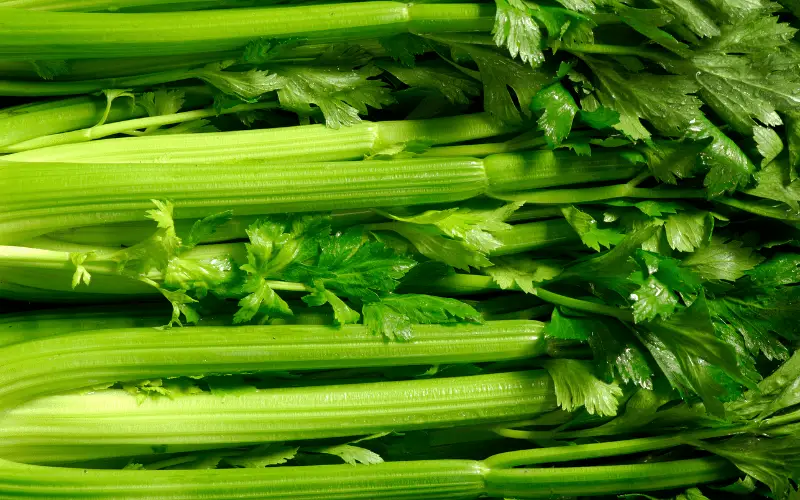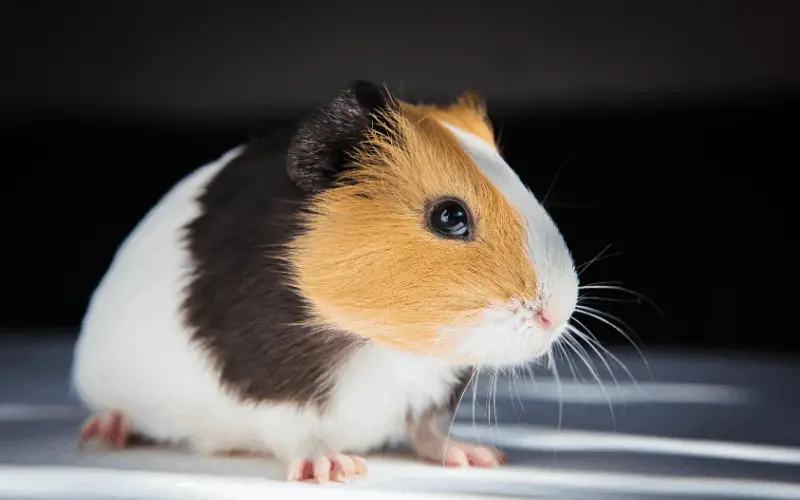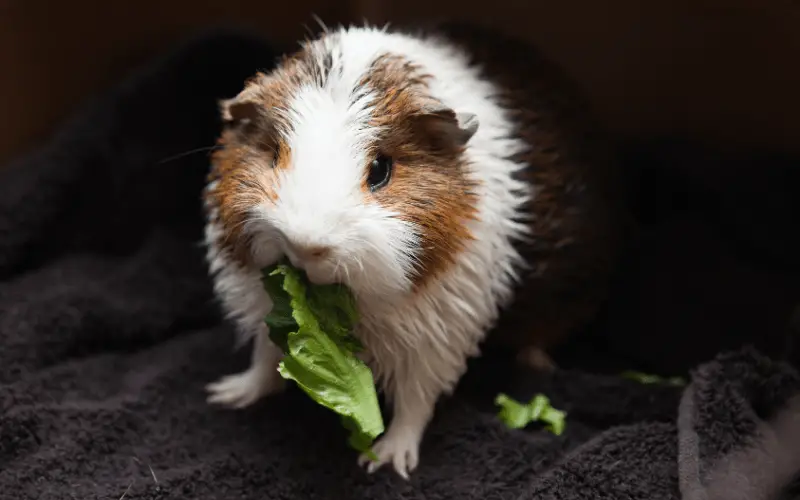Guinea pigs can make for great adorable pets, and while the cost of maintenance is relatively low, they are susceptible to sudden changes in food and environment. So, the introduction of new things to the daily routine should be a slow process.
There are many things guinea pigs can and cannot eat, which is why you must be careful while feeding them. But can guinea pigs eat celery? Is celery safe for guinea pigs? Well, the fact is that guinea pigs can eat celery without any problem.
Guinea pigs can also eat celery leave; however, there are a few things to keep in mind while feeding your piggies celery, and we’re going to discuss that below.
Let’s get started!
What is Celery?
According to Wikipedia:
Celery (Apium graveolens) is a marshland plant in the family of Apiaceae that has been cultivated as a vegetable since antiquity. Celery has a long fibrous stalk tapering into leaves.
Depending on location and cultivar, either its stalks, leaves, or hypocotyl are eaten and used in cooking. Celery seed is also used as a spice, and its extracts have been used in herbal medicine.
Can Guinea Pigs Eat Celery?
Yes, guinea pigs can eat celery as it’s an excellent veggie for guinea pigs, but when it comes to feeding your piggies with them, we advise you do it occasionally. There’s a thin line between safe and risky when it comes to the feeding of celery.
Guinea pigs cannot store or produce Vitamin C, which means that they need a somewhat constant supply of it. Celery is a veggie-rich with vitamin C but doesn’t over-do it with these little guys.
However, feeding guinea pigs too much celery leaves could lead to urinary tract stones. You should also never serve celery to your piggy if there’s a medical history of bladder stone or sludge.
Read Also: What Wild Plants Can Guinea Pigs Eat?
What Are The Benefits Of Celery?

Celery is a vegetable, and vegetables are crucial in nourishing Guinea pigs. It is an excellent source of some vital nutrients, which include:
- Supplementing Vitamin C
- Vitamin A
- Vitamin D
- Vitamin E
- Vitamin K
Being similar to Vitamin C, celery contains a lot of water-soluble vitamins such as B-Complex. This becomes essential for their overall health, especially in improving their gastrointestinal tract and preventing anemia.
Also, fat-soluble vitamins contained in Vitamins A, D, E, and K help improve their eyesight, maintain their growth and muscle strength and equally slow down the degeneration process.
Other benefits of feeding celery to your piggies include:
- Improves the cardiovascular system – celery has vitamins that help the heart perform better. This veggie can help your guinea pig live longer and healthier.
- Celery aids the digestive tract – guinea pigs usually have problems with the digestive tract, and that is why they need assistance for different foods. Celery happens to be one of the vegetables that aid in the digestion process due to dietary fiber. This also helps to control bowel movement.
- Prevents inflammation – celery has been found to contain apigenin responsible for the prevention of inflammation in guinea pigs.
- Lowers blood pressure – blood pressure should be maintained at optimum levels for the guinea pig to lead a healthy life.
- Reduces the risk of hyperlipidemia – this is a condition where fatty molecules increase in the bloodstream. Celery works to reduce the risk of this condition, which can affect your guinea pig’s heart health and lead to sudden death.
- Helps in neurogenesis – this is the growth and development of cells in the body. Apigenin that is found in celery is known to help in this process.
- Water retention ability – celery has excellent water retention ability that helps the guinea pig store water that it needs for survival.
- Helps prevent muscle spasms – guinea pigs sometimes suffer from muscle spasms that happen due to an imbalance in their body. That is why you need to give them celery to reduce or prevent such occurrences.
- It helps in the elimination of free radicals in the body – the presence of numerous nutrients in celery, including antioxidants, supports it in the removal of free radicals that may affect its health.
What Is Inside Celery? Is It Safe For Guinea Pigs?
It consists of a sufficient amount of other minerals and vitamins that help improve their health.
As a matter of fact, many guinea pig lovers serve celery with their lovely ones occasionally because of health benefits. Added in a small amount to their diet, fresh celery is a safe food and a healthy one.
However, the key is to include a small amount only. Veterinarians recommend feeding celery on an occasional basis because of oxalates of which celery contains a lot.
Oxalates can be harmful to their health. This potential risk is not limited to celery; a high dose of the chemical can also be found in other vegetables such as spinach, chard, and green beans.
Oxalates
Oxalates are a natural substance in many foods. They bind to calcium during digestion in the stomach and intestines and leave the body in the stool. Oxalate that is not bound to calcium travels as a waste product from the blood to the kidneys, leaving the body in the urine.
There are many different kidney stones types, but 8 out of 10 stones are calcium oxalate stones. If there are too much oxalate and too little liquid in the urine, calcium oxalate fragments create crystals.
As the crystals begin to increase in number, they stick to one another to form a larger crystal known as a kidney stone.
Kidney stones are a big concern for those who have or are at risk for kidney disease. The process of stone formation may cause damage to renal tissue, thus decreasing renal function
The Nutritional Content Of Celery
Below are the nutrition facts for celery, according to the USDA National Nutrient Database:
| Nutrients | Amount |
|---|---|
| Vitamin C | 3.1 mg/ 100 g |
| Vitamin K | 29.3 µg/100 g |
| Folate | 36 µg/ 100 g |
| Calcium | 40 mg/ 100 g |
| Phosphorous | 24 mg/ 100 g |
| Potassium | 260 mg/ 100 g |
| Fiber | 1.6 g/ 100 g |
| Sugar | 1.34 g/ 100 g |
| Protein | 0.69 g/ 100 g |
| Carbs | 2.97 g/ 100 g |
| Calories | 14 Kcal |
| Fat | 0.17 g/ 100 g |
| Water | 95.43 g/ 100 g |
According to Megan Ware, a registered dietician nutritionist in Orlando, Florida:
Since celery is mostly made of water (almost 95 percent), it is not particularly high in any vitamin or mineral.
Nevertheless, celery is a good source of vitamin K, with one cup containing about 30 percent of the recommended daily intake, according to the U.S. Food and Drug Administration (FDA). Celery can also help you get enough folate, potassium, fiber, and molybdenum.
It contains small amounts of vitamin C, vitamin A, and some B vitamins. Its seeds are a natural diuretic, according to the University of Maryland Medical Center:
Celery is naturally low in calories, carbohydrates, fat, and cholesterol,” added Ware.
How Should You Serve Celery To Guinea Pigs?

We recommend you give your guinea pigs the celery raw to eat. This is because cooking them destroys the nutrients in them. Guinea pigs are plant-eating animals and feed off raw foods, not cooked meals.
Raw foods preserve more nutrients than cooked foods, and your piggy’s digestive system operates well on a raw food diet. Cooking your piggy their meals may result in changes to the gut biome in your piggy’s GI tract, resulting in digestive issues like diarrhea.
They love to nibble fresh leaves, and as a matter of fact, their natural habitat doesn’t provide cooked food for them. Raw ones are much harder that can protect their teeth and oral health.
Furthermore, keep in mind that chemicals added during cooking that are safe for you don’t imply the same for your guinea pigs. Even though no additional ingredients are added during cooking, the cooking process will take away many nutrients, especially water-soluble ones.
The nibbling on raw foods like celery encourages teeth wearing.
Can Guinea Pigs Eat Celery Roots?
Yes, they can! Just be sure to wash them well and keep them all clean before feeding your piggies, as they can contain some amount of chemicals and fertilizers.
The following are some quick facts about celery:
- Celery cultivation started over 3000 years ago.
- It was first cultivated in the Mediterranean region.
- This plant grows well on clay and sandy soils.
- Celery does well in a temperate climate.
- Celery has medical and cosmetic uses.
- Its growth can go up to a height of 3.3 feet.
- The celery has an end of life cycle after every two years.
- In ancient times, celery was used as a bouquet to reward athletes who emerged winners in Greece.
- In the past, Romans used celery as an aphrodisiac.
- All the parts of the celery plant can be eaten.
- Celery became a part of the human diet in Italy during the 16th century.
- It was used to treat some ailments, including insomnia, toothache, anxiety, hypertension, and to purify the blood.
How Often Should Guinea Pigs Eat Celery?
Once or twice a week is fine – feeding celery more than twice in a week is not a good decision. You can safely provide celery stalks and leaves to your pet guinea pigs. Washing properly is necessary because of the possible dirt on celery leaves that cause the digestive problem.
Feed a small chunk of celery occasionally as a treat, which will be more beneficial for your piggies. By giving an excessive amount of celery, you won’t like to see the problems in the urinary tract of your guinea pig.
When feeding your guinea pigs celery stalks, we advise you to chop them into tiny or semi-tiny chunks to ensure they don’t choke.
Can Guinea Pigs Eat Celery Leaves and Sticks?
Guinea pigs can consume celery stems, sticks, and leaves without a problem. These are safe and healthier, too, if given in a controlled manner.
Too much consumption of celery parts can lead to urinary issues. When serving them, selecting the right amount is really an essential step for pet owners.
Read Also: How Much Hay is Enough For Guinea Pigs?
What Else Can Guinea Pigs Eat?
If you are looking for more information, walkthroughs and troubleshooting about Guinea Pigs and their diet, here are some additional posts you can check out:
Conclusion
In summary, yes, guinea pigs can eat celery, and it is highly nutritional for them. However, too much of it has proven to be dangerous as such, do it occasionally.
In this post, we have guided you through the most important things you need to keep in mind while dealing with your guinea pigs and giving them celery. Meanwhile, keep in mind that the staple part of their diet is hay.
Vegetables, including celery, should only be positioned as a supplement served in limited quantities. By acting in accordance with this, our guinea pigs can grow and stay healthy.
